By Jason Crawford Samios-Uy

Running Time: Approx. 2 hours and 40 minutes with one intermission
Baltimore and its people, through the years, have had their ups and downs but we always seem to bounce back no matter what. Neighborhoods come and go, some prosper,some try to hang on to a bygone era, and in every case, it’s the people who make the neighborhood what it is. Sometimes, It only takes a few pillars to keep a neighborhood going, even when it’s falling down around them, but it’s a tough fight, especially in Baltimore City. In Baltimore Center Stage’s latest production, A Wonder in My Soul by Marcus Gardley, Directed by Daniel Bryant, is one of those stories that take us back and forth between the past and present and tell a story of old friendships, family, and a resilient spirit that keeps us going, even in the darkest of times.

Briefly, A Wonder in My Soul concerns itself with two old friends, Swann Park Sinclair and Gwynn Oak Falls, who have a beauty salon they have operated since the early 60s in Baltimore City. As oflate, the neighborhood has gone downhill and has become a “bad” neighborhood and developers are buying up properties left and right to gentrify the area with coffee shop chains and supermarkets. One of the only shops left in the neighborhood is this beauty salon because of the respect these two ladies have earned over the years and the history it holds. Gwynn Oak Falls’ son, Andrew,has borrowed money from the two ladies to start a non-profit organization for inner-city children but is now under suspicion of embezzlement and the money is gone, leaving the two ladies in dire straits and months behind in rent on the space. A loving, but estranged relationship between Gwynn Oak Falls and her daughter,Cherry Hill, a Baltimore City police officer, don’t make matters much better. Through all this strife, the shop endures and welcomes regular customers like First Lady Cedonia Mosher of the local Baptist church and her new assistant, theyoung, hard-working, and pregnant Pen Lucy proving that with enough love, spirit,and strong faith we can endure. Marcus Gardley has crafted a well-written,deep-feeling story to which we can all relate in our own, individual way.
Scenic Design by Wilson Chin is impeccable as we are transported into an old salon that has been around for decades. The presentation of strong African-American female figures through the ages stirs up a certain pride and nostalgia that sets the mood for the piece. I found myself starting a little game with myself to see how many faces I could name… and I didn’t do too shabby! The authenticity of Chin’s design with salon stations and a sofa/coffee table pair for a waiting area, makes it all the more real, familiar, and immersive.
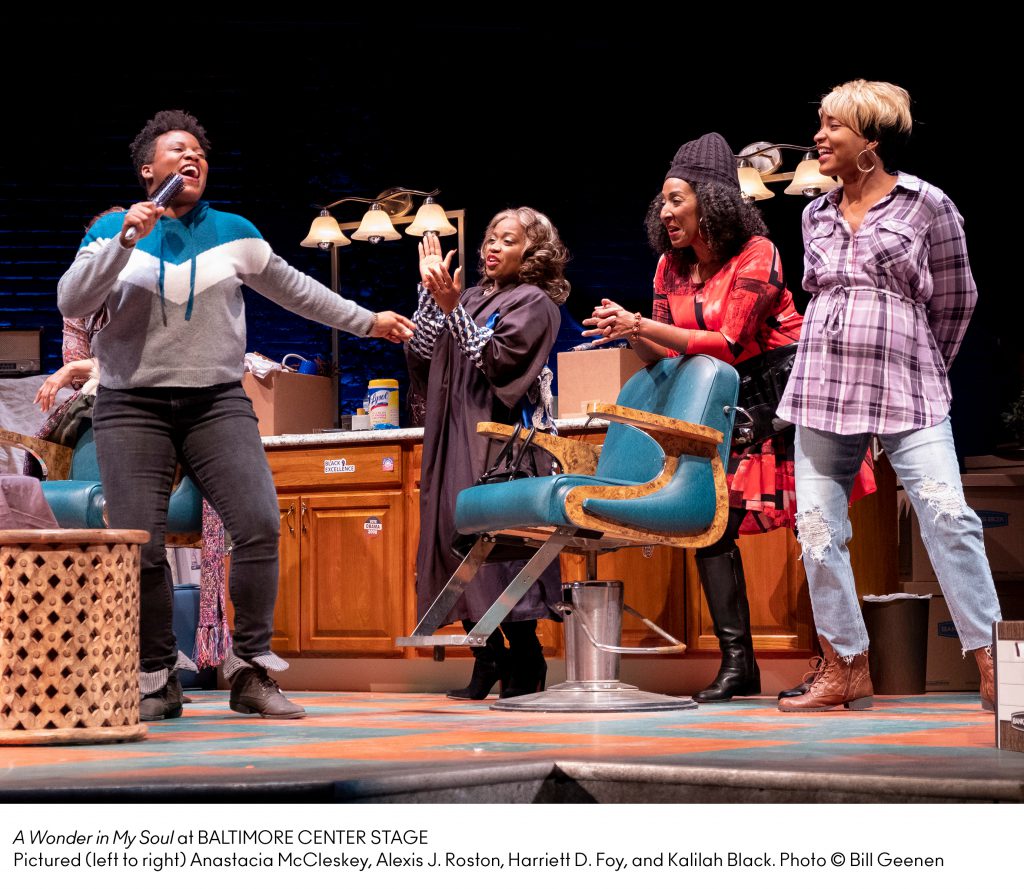
Working in tandem with Wilson Chin’s Scenic Design is Lighting Design by Kathy A.Perkins, Sound Design by Mikhail Fiksel, and Projection Design by Alex Basco Koch. Subtly is the key to Light and Sound Design and Perkins and Fiksel have accomplished it commendably. Small changes in light here and there to represent times of day as well as to divert the audience’s attention to important dialogue are spot on and appropriate. The sounds of the city are placed perfectly as well, including weather, which can be tricky to represent on stage without it looking and sounding generic, but this design is superb.
The Projection Design by Alex Basco Koch is absolutely superb and adds great value to the production. The high definition projections aren’t just decoration,either. They help move the story along and relate to the situation or dialogue making for a brilliant technical aspect to an already beautifully designed production.
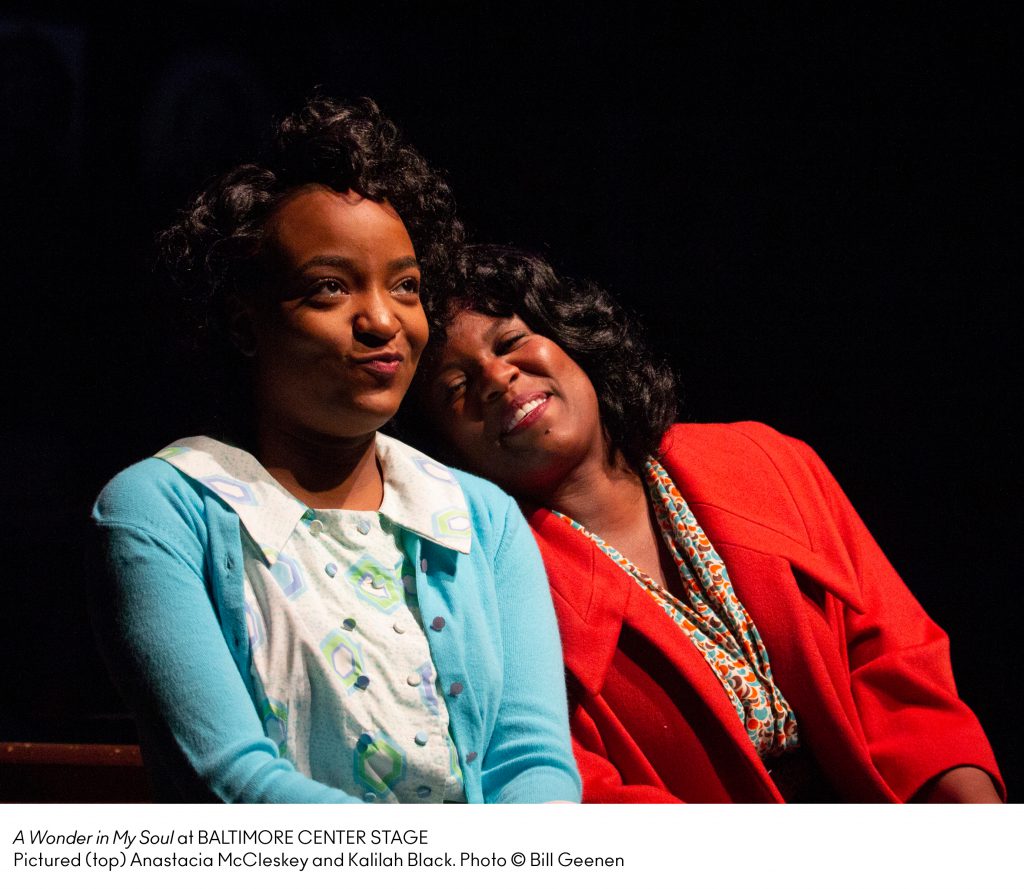
David Burdick gives us a stellar Costume Design that flip-flops between the decades, matching every decade with great detail and flair. The present day attire is on point and the fashions of the past are spot on making for a brilliant design. A magnificent Hair and Wig Design by Cherelle D. Guyton also add to this production, with each character having his or her own style and individuality adding to the realism and character each actor is portraying. Kudos to both Burdick and Guyton for jobs well done.
Taking the Music Direction reigns of this production is Jaret Landon and under Landon’s direction (along with some impressive original music and arrangements) the musical aspect of this piece shines through and makes its mark on the audience. Using old spirituals, both upbeat and slow tunes, Landon has weaved together a wonderful program that helps move the story along without hindering the action. The arrangements are spot on for these talented actors and actresses and will have you toe-tapping and getting all the feels when the cast really gets going, musically.
Daniel Bryant takes the helm of this production and his Direction shows he has a tight grasp on this material and text. His staging is stellar and keeps the audience engaged while telling this poignant story. Though Gardley’s witty but thoughtful script gives the actors everything they need, Bryant still knows how to balance the humor and the poignancy exquisitely. Bryant should be applauded and commended for his work on this production.
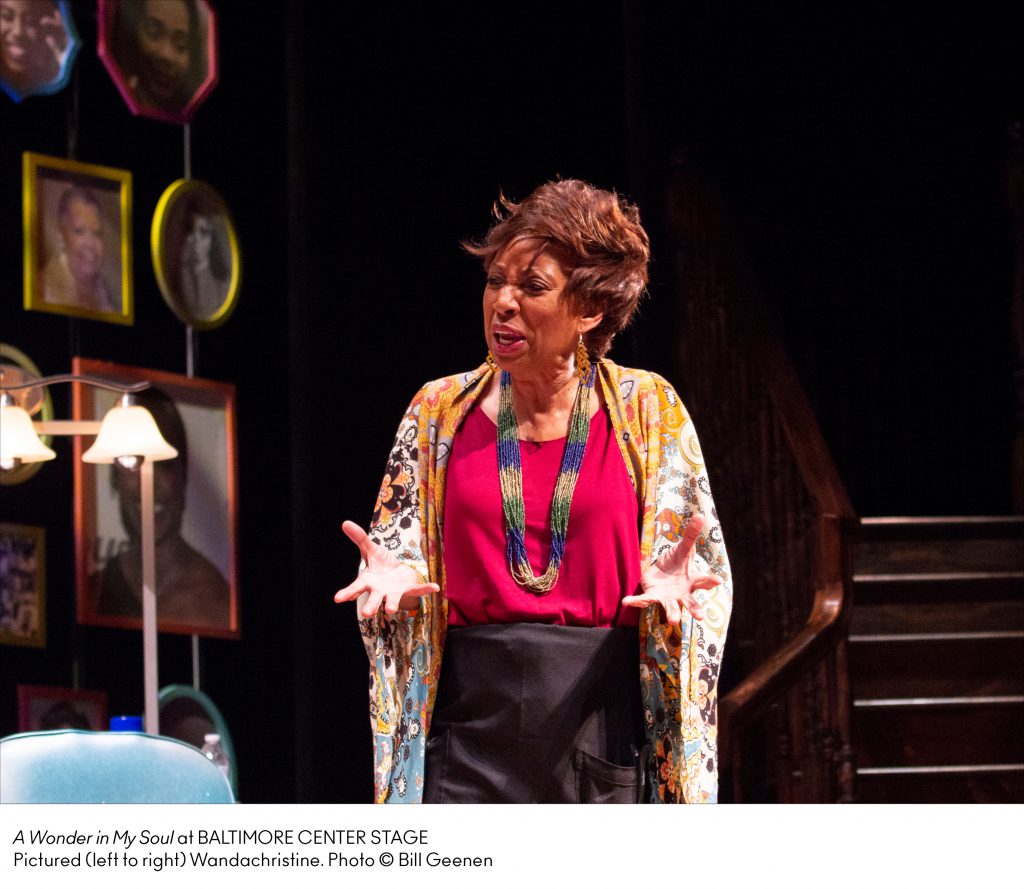
Moving on to the performance aspect of this production, Stanley Andrew Jackson III takes on the supporting role of Andrew Hill, aspiring non-profit head and son of Gwynn Oak Falls. Jackson knows this character and, though he has less stage time than the other characters, he plays him to the hilt. He seems to understand the anguish and conflict in this character and plays him with even balance and not over the top. Jackson makes the most of his stage time and his steady portrayal is admirable.
Two of the actors in his piece take on double duty and Kalilah Black as PenLucy/Young Gwynn and Anastacia McCleskey as Cherry Hill/Young Swann pull of the roles superbly. Both Black and McCleskey have a great comprehension of the characters they are portraying and as the younger Gwynn and Swann, their chemistry is undeniable and work well with and off of each other adding to the depth of these characters. As Pen Lucy, Black is absolutely believable as a modern, single mother trying to make ends meet with a good head on her shoulders and McCleskey gives a heartfelt portrayal of Cherry Hill, Gwynn’s older, police officer daughter showing the hurt and loyalty this character has for her mother. It’s worth mentioning that, vocally, McCleskey is a powerhouse and blows it out of the water with her rendition of a heartbreaking ballad in Act II. The ability to play two characters back to back (with some breakneck costume changes, it seems) is impressive and both actresses give strong,confident performances that are joy to watch.
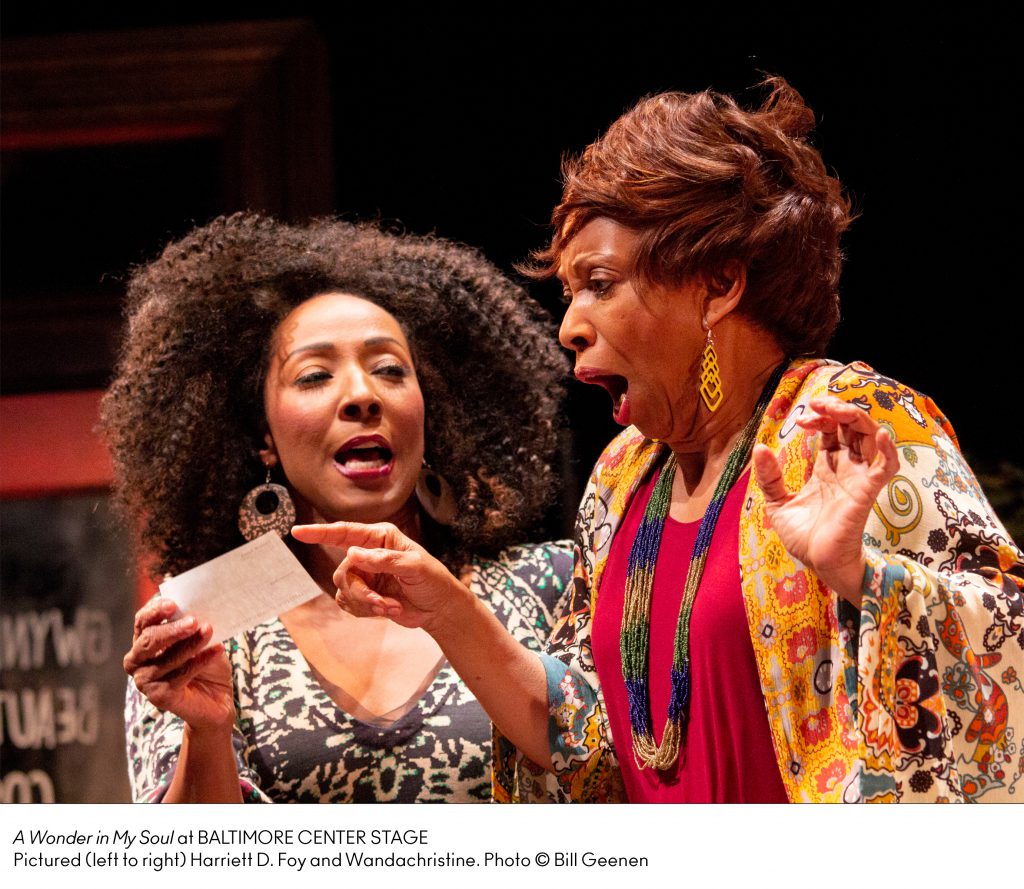
Leading the troupe are Wandachristine as Gwynn Oak Falls and Harriett D. Foy as Swann Park Sinclair and both of these ladies are highlights of this production. Both of these actresses give intense, humorous, and earnest performances that make these characters the heart of the story. Wandachristine is convincing as an aging, but sassy and self-reliant Gwynn Oak Falls and gives an impressive showing, especially her spoken-word monologue at the top of Act II that she delivers flawlessly. Working alongside of Wandachristine, Harriett D. Foy is a driving force as Swann Park Sinclair with an impeccable delivery of the text and a tight grasp of what her character is all about. From her quick and witty one-liners to her portrayal of the regret this character harbors, Foy gives an excellent and strong showing that is a pleasure to experience. The connection these actresses make with the audience is amazing and makes every spectator feel at home, as if they were sitting in that little salon with these ladies and that,my friends, makes for great theatre. These are two performances you don’t want to miss.
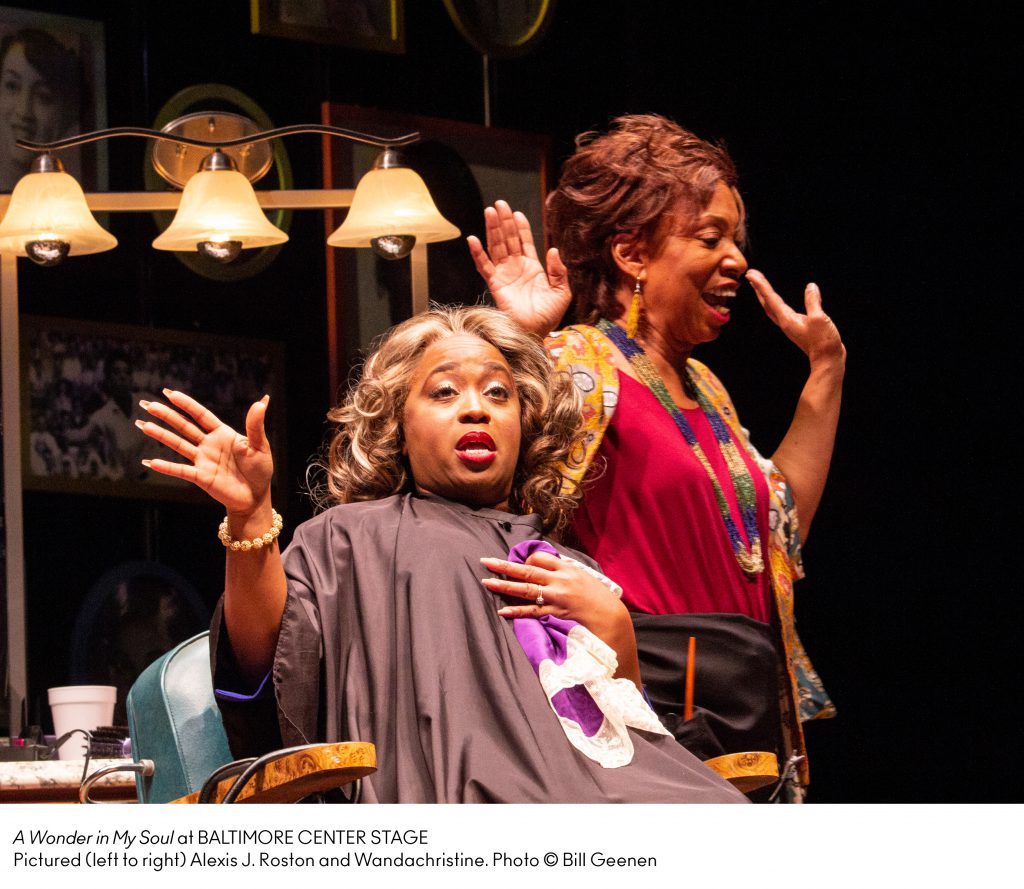
Last but certainly not lease, we have another actress in a supporting role but AlexisJ. Roston as First Lady Cedonia Mosher is the standout in this production of A Wonder in My Soul. Roston hits the ground running as First Lady Cedonia. The first time we see this character, she enters the salon singing and turns it into a mini revival with “Jesus Is My Friend”, equipped with her own tambourine and all. Roston has a lot of quick one-liners in her dialogue, but her character is my favorite because of the transition we see in her throughout the piece – a transition that Roston handles delicately and ably. First Lady Sinclair is a class above the rest,financially anyway, but she keeps coming back to the salon in the “bad” part oftown because she has a connection with these ladies and vice versa. From domineering to endearing, Roston pulls off her role immaculately and effortlessly. Vocally, Alexis J. Roston is another powerhouse and diverse vocalist who wails out the old-timey spirituals, as well as 60s hits, and modern grooves all in one night. I’m looking forward to seeing future performances from this actress.
Final thought… A Wonder in My Soul at Baltimore Center Stage is a heartfelt,hometown story that incorporates good old fashioned gospel music, a well-written script, and thoughtful performances that resonate with you long after you leave the theatre. A lot of theatre can speak to you, but there’s something about this piece that touches your soul, as the title suggests.There’s nothing supernatural, per say, and no big bells and whistles, but the story itself, about family, long friendships, and living life the best way you know how is one that will stick with you and make you think. All aspects of this production including Set Design, Costumes, Lighting and Sound Design, and staging make for a splendid experience you do not want to miss this season and you’ll want to get your tickets as soon as you can.
This is what I thought of Baltimore Center Stage’s A Wonder in My Soul… What did you think? Please feel free to leave a comment!
A Wonder in My Soul will play through December 23 at Baltimore Center Stage, 700North Calvert Street,Baltimore, MD. For tickets, call the box office at 410-332-0033 or you can purchase them online.
Email us at backstagebaltimore@gmail.com
Like Backstage Baltimore on Facebook
Twitter @BackstageBmore
Instagram @backstagebaltimore


 Jazz
Jazz Production value at Baltimore Center Stage is always stellar and
Production value at Baltimore Center Stage is always stellar and 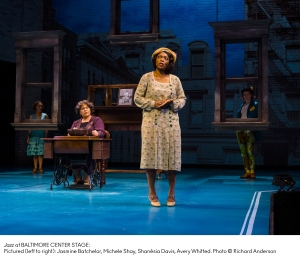 Costume Design by David Burdick is spot on representing the styles of the eras this piece covers. His attention to detail is superb with the low waist skirts for the younger ladies and the more conservative look of the older folks. It’s worth mentioning that Burdick does a great job showing the contrast between the fashions of the generations and he understands this piece does not require the glitz and glamour of the Jazz Age, but has managed to put together a wardrobe portraying the middle to low class residents of Harlem and all of his choices give the entire piece a very authentic feel.
Costume Design by David Burdick is spot on representing the styles of the eras this piece covers. His attention to detail is superb with the low waist skirts for the younger ladies and the more conservative look of the older folks. It’s worth mentioning that Burdick does a great job showing the contrast between the fashions of the generations and he understands this piece does not require the glitz and glamour of the Jazz Age, but has managed to put together a wardrobe portraying the middle to low class residents of Harlem and all of his choices give the entire piece a very authentic feel. This script jumps through time periods and points of view and if I didn’t have the program to give me a timeline of the story, I may have been lost so, I can tell it’s a challenging piece. Through his Direction of this piece, Kwame Kwei-Armah tries to keep it all together, and does for the most part, but the disorienting script is difficult to reign in and the story seems to spill out all over the place. Kwei-Armah keeps the action moving and he seems to have a good comprehension of the material but his choice of using the cast to make the minimal scene changes with no real blackouts to separate scenes might have added to the confusion concerning time periods and points of view. I totally understand his reasoning as it is a 90-minute show with no intermission so, you’ve got to keep the action moving, but perhaps at least a few projections or markers to keep the audience on track may have been helpful. Overall, Kwei-Armah does an admirable job and tells the story as best he can with the material given to him.
This script jumps through time periods and points of view and if I didn’t have the program to give me a timeline of the story, I may have been lost so, I can tell it’s a challenging piece. Through his Direction of this piece, Kwame Kwei-Armah tries to keep it all together, and does for the most part, but the disorienting script is difficult to reign in and the story seems to spill out all over the place. Kwei-Armah keeps the action moving and he seems to have a good comprehension of the material but his choice of using the cast to make the minimal scene changes with no real blackouts to separate scenes might have added to the confusion concerning time periods and points of view. I totally understand his reasoning as it is a 90-minute show with no intermission so, you’ve got to keep the action moving, but perhaps at least a few projections or markers to keep the audience on track may have been helpful. Overall, Kwei-Armah does an admirable job and tells the story as best he can with the material given to him. The entire ensemble of Jazz is committed and dedicated to this piece an, aside from the material, they all do a commendable job telling this poignant story and work hard to get the message across. Among the able ensemble, Michele Shay takes on the role of Alice Manfred and Leon Addison Brown portrays an older Joe Trace. Shay, though a bit scripted, does a fine job portraying the elderly, more wise female figure with down-home common sense and compassion. She clearly understands her character and keeps it consistent throughout the production. Brown, as older Joe, is also a bit stiff at times, but his comprehension of the character is clear and the emotion he exudes of a man yearning for something more than his lot is impressive.
The entire ensemble of Jazz is committed and dedicated to this piece an, aside from the material, they all do a commendable job telling this poignant story and work hard to get the message across. Among the able ensemble, Michele Shay takes on the role of Alice Manfred and Leon Addison Brown portrays an older Joe Trace. Shay, though a bit scripted, does a fine job portraying the elderly, more wise female figure with down-home common sense and compassion. She clearly understands her character and keeps it consistent throughout the production. Brown, as older Joe, is also a bit stiff at times, but his comprehension of the character is clear and the emotion he exudes of a man yearning for something more than his lot is impressive. Warner Miller is comfortable playing the role of Young Joe Trace, an ambitious, go-getter, and gives a believable and confident performance. Miller has a good command of the stage and makes the character likable from the get. Meanwhile, Jasmine Batchelor tackles the role of Dorcas, the young, beautiful “other woman,” and she is the epitome of a young woman in the 1920s. She’s authentic and assured, playing the character with just the right balance of naivete and rebellion that the character requires.
Warner Miller is comfortable playing the role of Young Joe Trace, an ambitious, go-getter, and gives a believable and confident performance. Miller has a good command of the stage and makes the character likable from the get. Meanwhile, Jasmine Batchelor tackles the role of Dorcas, the young, beautiful “other woman,” and she is the epitome of a young woman in the 1920s. She’s authentic and assured, playing the character with just the right balance of naivete and rebellion that the character requires.  A couple of highlights of this production are Jasmine Carmichael as Young Violet and Shanesia Davis as the older Violet, the character around whom the story revolves. The character of Violet is the most complex and has obvious emotional problems that are not necessarily explained aside from past losses and issues but both of these actresses play the character well and with an intensity needed for the role. Carmichael is outstanding as the Young Violet and seems comfortable and assured in her objectives playing a young girl starting out while Davis portrays the character a little more beat down by the world but who is a survivor and getting by as best she can, while fighting the emotional unbalance in her. Both bring an authenticity to the role that makes the audience feel for their plight and, in the end, root for this character. Both actors have great chemistry with their counterparts (Warner Miller for Carmichael and Leon Addison Brown for Davis), and they work well with their cast mates making for exquisite performances.
A couple of highlights of this production are Jasmine Carmichael as Young Violet and Shanesia Davis as the older Violet, the character around whom the story revolves. The character of Violet is the most complex and has obvious emotional problems that are not necessarily explained aside from past losses and issues but both of these actresses play the character well and with an intensity needed for the role. Carmichael is outstanding as the Young Violet and seems comfortable and assured in her objectives playing a young girl starting out while Davis portrays the character a little more beat down by the world but who is a survivor and getting by as best she can, while fighting the emotional unbalance in her. Both bring an authenticity to the role that makes the audience feel for their plight and, in the end, root for this character. Both actors have great chemistry with their counterparts (Warner Miller for Carmichael and Leon Addison Brown for Davis), and they work well with their cast mates making for exquisite performances.